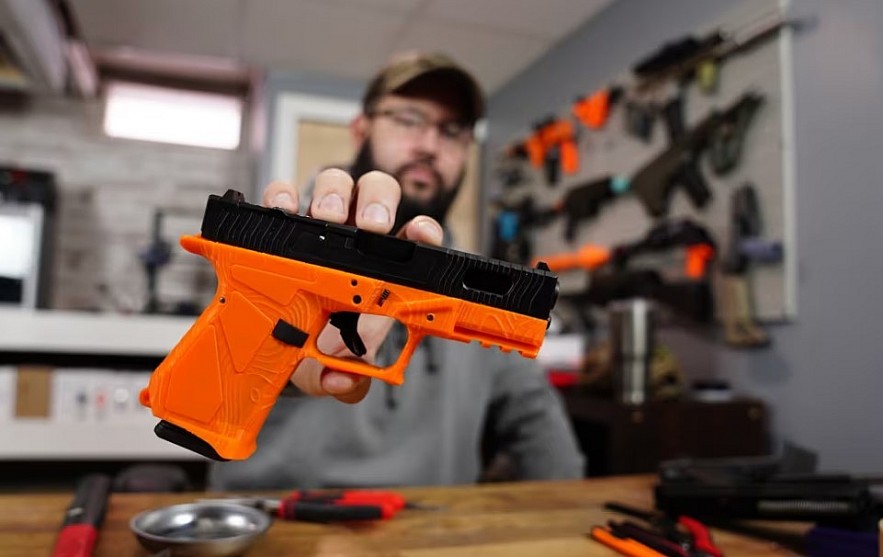What Are 3D-Printed Guns? Exploring the Weapon Linked to Luigi Mangione
 What are 'Ghost Guns' and Why Are They So Dangerous? What are 'Ghost Guns' and Why Are They So Dangerous? In recent years, the term "ghost gun" has entered public discourse with increasing frequency, raising concerns among lawmakers, law enforcement agencies, and the general populace ... |
The use of 3D-printed guns, also known as ghost guns, has become a contentious issue in modern law enforcement and public safety. These untraceable weapons, created using advanced additive manufacturing techniques, bypass traditional firearm regulations, posing significant challenges to authorities.
What Are 3D-Printed Guns?
 |
| Untraceable 3D-printed 'ghost guns' |
3D-printed guns are firearms manufactured using additive manufacturing techniques. Unlike traditional firearms, these weapons can be assembled at home using components produced with 3D printers. The term ghost guns refers to their untraceable nature, as they lack serial numbers and can circumvent existing firearm regulations.
Parts to Play
One of the primary appeals of ghost guns is the ability to produce key firearm components without federal oversight. Under U.S. law, the lower receiver, or "lower," is the only gun part requiring a background check when purchased from licensed dealers. Other components, such as slides, barrels, and trigger mechanisms, are unregulated and can be purchased online from aftermarket vendors.
This loophole allows individuals to produce fully functional firearms at home, often packaged as do-it-yourself (DIY) gun kits. These kits vary in complexity; some require basic assembly skills, while others involve more technical expertise depending on the number of metal parts used.
In Mangione’s case, authorities recovered a pistol with a plastic handle, a metal slide, and a threaded metal barrel capable of attaching a suppressor. Investigators say the weapon matches the one seen in security footage of the shooting and can fire the 9mm round found at the crime scene. Experts suggest the firearm may be a Chairmanwon V1, a variant of the popular 3D-printed Glock clone known as the FMDA 19.2.
How Ghost Guns Evade Regulation
Ghost guns take advantage of gaps in existing firearm laws, making them particularly difficult to regulate. Under current federal law, many individual firearm parts are not subject to oversight, allowing individuals to skirt background checks and other controls.
Challenges in Regulation
- Lack of Serialization: Traditional firearms must have serial numbers for tracking and tracing. Ghost guns, made from 3D-printed components or DIY kits, lack this key identifier.
- Provenance Issues: The lack of manufacturing records for ghost guns complicates law enforcement efforts to trace their origins.
- Accessibility: Digital blueprints for 3D-printed guns are widely available online, enabling individuals to produce firearms without purchasing regulated components.
Connection to Luigi Mangione
Luigi Mangione, the prime suspect in Brian Thompson’s murder, allegedly used a 3D-printed ghost gun in the crime. Authorities report that the weapon, discovered during his arrest, featured both 3D-printed and metal components. Its untraceable nature made it difficult for investigators to track until Mangione’s capture.
This weapon’s design, which included a threaded barrel to attach a suppressor, aligns with the ghost gun’s reputation for customization and functionality. Investigators believe its untraceability allowed Mangione to evade detection prior to his arrest.
The Black Market for Ghost Guns
The proliferation of ghost guns has created an underground market that is challenging to police. While ghost guns are often associated with DIY manufacturing, they are increasingly available through illicit channels.
Rising Popularity and Enforcement Challenges
• Surging Popularity: Ghost guns have become more prevalent in the past decade. The Department of Justice reported over 25,000 ghost guns seized domestically as of 2022.
• Regulatory Uncertainty: In 2022, the Biden Administration introduced regulations requiring serial numbers on gun kits. However, these rules face legal challenges and are currently in limbo.
• Lack of Data: Due to their untraceable nature, reliable statistics on ghost guns in circulation or their involvement in crimes are scarce.
Cases Highlighting the Dangers of Ghost Guns
Ghost guns are increasingly linked to criminal activity, illustrating the risks posed by these unregulated firearms. High-profile cases include:
• Luigi Mangione and the Brian Thompson Murder (2024): Mangione’s alleged use of a ghost gun in the murder of UnitedHealthcare CEO Brian Thompson underscores the weapon’s role in enabling premeditated violence.
• Halle Synagogue Shooting (2019): A gunman in Germany used a homemade firearm, including 3D-printed components, in an attack that killed two people.
• Rising Ghost Gun Seizures in the U.S.: Law enforcement agencies report an increasing number of ghost guns linked to violent crimes, highlighting their growing appeal among criminals.
Efforts to Combat Ghost Guns
Governments and advocacy groups are working to address the ghost gun crisis, but progress is slow due to legal challenges and technological advancements.
Proposed Solutions
Serialization of Gun Kits: Mandating serial numbers on firearm components, including those in DIY kits, could help close regulatory gaps.
Monitoring Online Blueprints: Stricter enforcement to remove 3D-printed gun blueprints from the internet is essential.
Enhanced Enforcement: Law enforcement agencies need additional resources to track and prevent the proliferation of ghost guns.
The Mangione Case and Its Implications
The alleged use of a ghost gun in the murder of Brian Thompson highlights the urgent need for stricter regulations and enforcement. Mangione’s weapon, a combination of 3D-printed and metal parts, demonstrates the sophistication of modern ghost guns and their potential for misuse.
A Stark Warning
The Mangione case serves as a wake-up call about the dangers of ghost guns. Without comprehensive regulation and enforcement, these untraceable firearms will continue to pose significant risks to public safety.
Conclusion
Ghost guns, including 3D-printed firearms like the one allegedly used by Luigi Mangione, represent a growing challenge for law enforcement and policymakers. Their untraceable nature and ease of manufacture make them a favored tool for criminals, while their increasing prevalence threatens to undermine decades of progress in gun regulation.
As the Mangione case unfolds, it sheds light on the need for stronger laws, better enforcement, and public awareness to address the ghost gun crisis. Balancing the innovative potential of 3D printing with the imperative to protect public safety will be crucial in the years ahead.
FAQs About 3D-Printed Guns and the Luigi Mangione Case
1. What are 3D-printed guns?
3D-printed guns are firearms manufactured using 3D printing technology. These weapons are often referred to as ghost guns because they lack serial numbers and are untraceable. They can be made from digital blueprints and materials such as plastic or metal.
2. Why are they called ghost guns?
The term “ghost guns” is used because these weapons are unregistered and lack identifying serial numbers, making them invisible to traditional tracking and regulatory systems.
3. What connection does Luigi Mangione have to 3D-printed guns?
Luigi Mangione, the suspect in the murder of UnitedHealthcare CEO Brian Thompson, allegedly used a 3D-printed ghost gun in the crime. Police recovered the weapon, along with a silencer, during his arrest in Altoona, Pennsylvania.
4. Are 3D-printed guns legal?
The legality of 3D-printed guns varies by jurisdiction. In many places, it is legal to produce them for personal use, but selling or distributing them without serialization and compliance with firearm regulations is illegal. However, their untraceable nature poses significant challenges for law enforcement.
5. Why are ghost guns a growing concern?
Ghost guns are a concern because they:
- Bypass background checks and regulations.
- Are untraceable in criminal investigations.
- Can be produced by anyone with access to a 3D printer and materials.
6. How do 3D-printed guns impact public safety?
3D-printed guns undermine efforts to control firearm-related violence. Their ease of production and lack of traceability make them appealing for criminal use, as seen in the Mangione case.
7. What is the link between ghost guns and crime?
Ghost guns have been increasingly linked to crimes due to their accessibility and untraceable nature. In addition to the Mangione case, they have been used in high-profile incidents like the Halle synagogue attack in Germany and numerous violent crimes in the United States.
8. How are authorities responding to the ghost gun crisis?
Authorities are working on measures such as:
- Banning or restricting access to firearm blueprints online.
- Requiring serialization of gun components, including 3D-printed parts.
- Increasing public awareness of the risks associated with ghost guns.
9. Can ghost guns be detected by metal detectors?
Some ghost guns, particularly those made entirely of plastic, may not be detectable by standard metal detectors. However, most functional models require metal components, such as barrels or firing pins, which can be detected.
10. What are the challenges in regulating ghost guns?
Regulating ghost guns is challenging due to:
- Decentralized access to digital blueprints.
- Variability in state and national laws.
- The ability to produce guns at home without oversight.
11. Did Luigi Mangione manufacture his own ghost gun?
While the exact source of Mangione’s ghost gun is under investigation, authorities believe it was either self-manufactured or assembled using 3D-printed parts and other components.
12. What can be done to address the threat of ghost guns?
Efforts to address ghost guns include:
- Implementing stricter laws requiring serialization of all firearm components.
- Educating the public on the dangers of ghost guns.
- Collaborating internationally to control the distribution of firearm blueprints.
13. How did the Mangione case highlight the dangers of ghost guns?
The Mangione case demonstrates how ghost guns can be used in high-profile crimes, evading traditional regulatory systems. The case has renewed calls for stronger measures to prevent their misuse.
14. Is it possible to stop the spread of ghost guns entirely?
While it may be impossible to eliminate ghost guns completely due to the decentralized nature of 3D printing, stronger laws, better enforcement, and increased public awareness can significantly reduce their prevalence and impact.
 What's Inside Luigi Mangione's Manifesto? What's Inside Luigi Mangione's Manifesto? Inside Luigi Mangione’s Manifesto: “Sorry for the Trauma,” “I Acted Alone” |
 Luigi Mangione: The Wealthy Heir Behind the Suspect Murder of Brian Thompson Luigi Mangione: The Wealthy Heir Behind the Suspect Murder of Brian Thompson The arrest of Luigi Mangione in connection with the murder of UnitedHealthcare CEO Brian Thompson has not only shocked the public due to the crime’s ... |
 Kathleen Mangione’s Plea: The Mother at the Heart of Luigi Mangione’s Tragic Downfall Kathleen Mangione’s Plea: The Mother at the Heart of Luigi Mangione’s Tragic Downfall Luigi Mangione’s mother, Kathleen Mangione, became an unexpected focus of public attention following her son’s arrest. |
 The tragic case of Brian Thompson: Luigi Mangione, Corporate resentment, and UnitedHealthcare crisis The tragic case of Brian Thompson: Luigi Mangione, Corporate resentment, and UnitedHealthcare crisis The shocking murder of UnitedHealthcare CEO Brian Thompson has sparked intense reactions due to its chilling nature and potential implications for the healthcare industry. |























